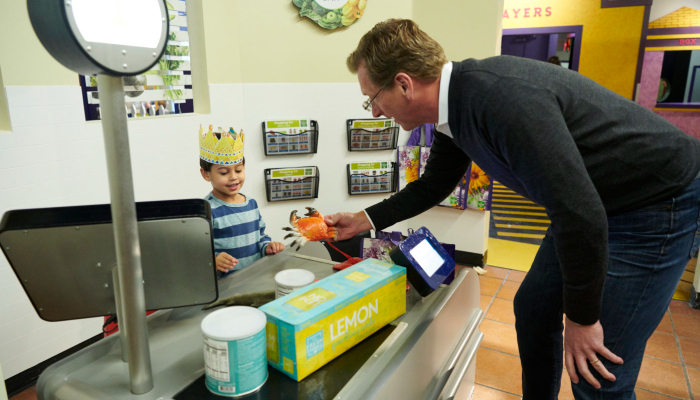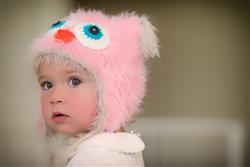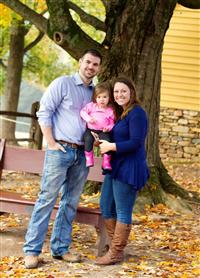Four Ways to Sharpen Your Preschooler’s Math Skills
By Guest Blogger Stephanie Ashton, Director of Education and The Edible Schoolyard at the Greensboro Children’s Museum
At Greensboro Children’s Museum many of our exhibits include unique, hands-on ways to introduce math concepts to young children. Math, like many subjects in school, starts with a good foundation of math-centric language, understanding of basic concepts, and practice. Fortunately, adding math to your preschooler’s already busy schedule doesn’t have to feel overwhelming. Below, you’ll find a few ways I’ve started incorporating math into our daily routines. As a mom, my hope is that by doing these activities at home, I’ll both deepen their understanding of what they’re learning at school as well as inspire them to love learning throughout their lives.
Count on Chores
In my house, chores start early and happen often. They build confidence and self-sufficiency and as a bonus they provide extra opportunities for hands-on learning. Think through some chores that require counting or measuring and put them into the regular rotation. As with any life skill, remember that your child is new to the world and may or may not know how to complete a task. Follow these steps with your toddler to improve the likelihood of their success: do it together and explain why, monitor and encourage, and check and praise. Here are a few ideas to give you a starting point.
- Feed the cat ¼ cup of cat food before breakfast.
- Set the table for each person in your family. Everyone will need a plate, napkin, fork and water glass.
- Fold the towels into a rectangle. Fold the t-shirts in half and then roll them into cylinders.
- Clean the table by giving it five squirts of cleaner and then wiping the whole surface.
- Go to the garden and pick the two biggest zucchini.
Modified Card Games
If you don’t already have a family game night in your weekly schedule, now is a great time to implement one! Start with simple card games like Go Fish, Uno, or Crazy 8s. At age 2 or 3, your child is probably ready to be on a team with a grown-up helping to recognize the cards and practice taking turns. Watching how you win or lose will help them gain a better understanding of game decorum as well. By ages 3 or 4, deal them their own hand and consider having all players play their cards face up. This will give them the independence they crave while allowing you to help them make choices if they get stuck. Finally, grab an empty binder and allow them to spread the cards out so that they can see while also creating a privacy screen from the other players. Be sure to have them say the number’s name aloud as they play each card.
Card game tips to remember:
- Have them say the name of the card number and the color or the suit they play to help build memory.
- If they make a number recognition mistake, encourage them to take a second look and try again. If they are really struggling, offer a type of help that empowers rather than replaces. “I see that you are starting to feel frustrated, can I help you get started again? Let’s take a look at your cards and see which one you want to play.”
- If they make a strategy mistake, keep on playing! Focusing on the fun over winning will elevate their learning experience and create feelings of success no matter the outcome.
- If you find that your child can not sustain their interest for more than a few minutes or becomes very frustrated at the idea of taking turns, don’t sweat it! Put the card games away for a month or two and try again. Your child is growing emotionally and intellectually at lightning speed and just needs a little more time for a structured game like cards.

Pattern Play
Pattern recognition is an important skill to developing proficiency in reading and math. You can start practicing pattern recognition with your child early and with little to no supplies. Here are two of my favorite ways for toddlers and preschoolers.
Option 1: Using dot markers, LEGOs, or other simple shapes, create a basic pattern like red dot, blue dot, red dot, etc. See if your toddler can repeat the pattern using the markers herself. If your child picks up the concept quickly, increase the difficulty of the pattern. Remember the tone of this activity should be of a fun game or challenge where a mistake made means, “So close, let’s try again!” If your child is struggling with the idea of patterns, try singing the colors with a simple tune or take a break and then try the next technique.
Option 2: Think back to playground clapping games that were accompanied by a song like Miss Mary Mack – both the song and movements were all about patterns and rhythm. With a 2-4 year old, you can follow this same idea to practice patterns. Sing and perform the words stomp, clap, pat, stomp, clap, pat. Once your toddler or preschooler is mastering a few sequences, ask if they want to make one for you to follow.

Read All About It
Honestly, any picture book can be a math book when you talk with your child about what they see. Asking your child questions like the ones below will help them to build their math vocabulary.
- Look at all those butterflies on this page. Do you want to count them with me?
- How many eggs are in that nest?
- Which animal has a longer neck, the giraffe or the zebra?
- Which basket has more apples in it?
- What do you think will happen first, second, third, last?
Learning about math can make for hours of fun. Here’s a list of math books for early learners. Let us know how you incorporate math and learning in your homes by posting to our Facebook page with this blog!
About the author: I came to Greensboro from my home state of Ohio by way of UNC – Chapel Hill where I received my Masters of Public Administration. I transitioned from working in economic development in the areas of business retention and entrepreneurship to my current role as the Director of The Edible Schoolyard and Education at GCM. I love seeing first-hand how inspired kids are while working in the garden or in cooking classes. When I’m away from the Museum, you’ll find me cooking, playing with my two young children, and enjoying three out of four of the seasons.
Want to see more blogs like this and get notifications on local events and happenings? Subscribe to our free weekly newsletters here.







